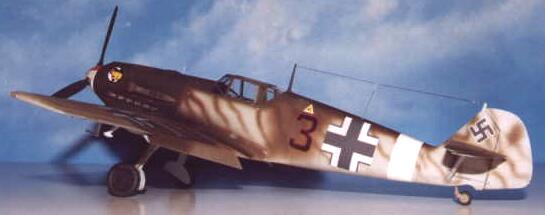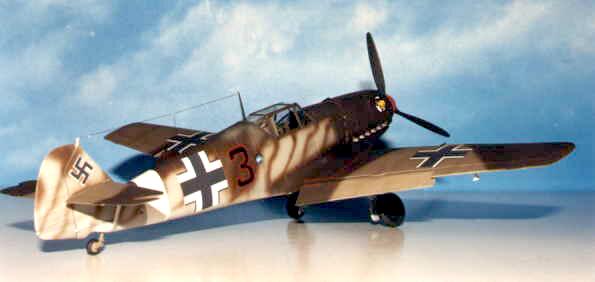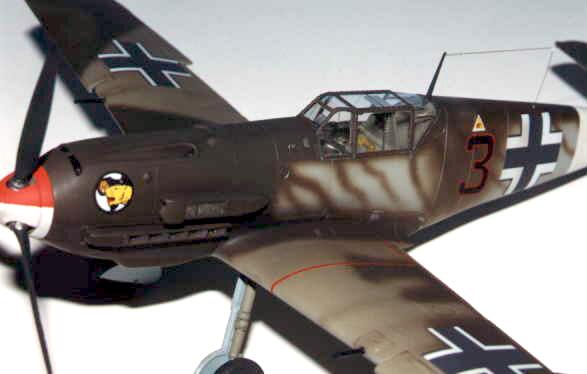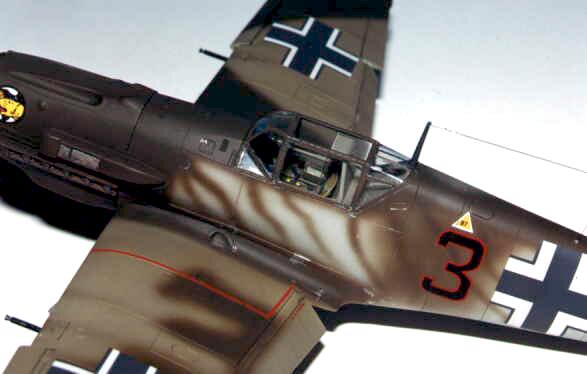![]()
Messerschmitt
Bf 109E-4 Trop
by
David Lake
|
Messerschmitt
Bf 109E-4 Trop |
| I n T h e B o x |
 Tamiya has certainly
listened to the modeling community regarding their release of the early 109s. The first
release E-3 version had some very visible problems with the shape of the nose angles, the
oil cooler and the prop blades. In releasing the E-4 version, Tamiya has taken the time to
correct the errors in the previous kit leaving us with only the skinny prop blades to
complain about.
Tamiya has certainly
listened to the modeling community regarding their release of the early 109s. The first
release E-3 version had some very visible problems with the shape of the nose angles, the
oil cooler and the prop blades. In releasing the E-4 version, Tamiya has taken the time to
correct the errors in the previous kit leaving us with only the skinny prop blades to
complain about.
A new sprue of clear parts with the correct squared off canopy replaces the E-3 parts.
| C o n s t r u c t i o n |
The kit goes together with all the ease we have come to expect from Tamiya. It is almost as simple as pouring some glue in the box and shaking! There was just a spot of putty needed on the lower wing to fuselage joint. Other than that one spot the kit fit perfectly. The cockpit is reasonably detailed, however I elected to used Hawkeye Designs excellent resin interior. While designed for the Hasegawa E’s, the Hawkeye set fits into the Tamiya kit with very little work. There is enough excess length in the prop blades to carefully shorten and reshape the tips of the blades. While the prop blades are still too narrow, rounding off the tips helps the overall look. The radio antenna wires were rigged using 1/2 pound test monofilament fishing line.

| C o l o r s a n d M a r k i n g s |
Images of my subject aircraft show up in almost every publication dealing with the Luftwaffe in North Africa.
The tiger stripes make for a striking and very different looking 109. Bf-109s coming to North Africa usually arrived in their European paint schemes. As soon as time and conditions allowed, airframes had some form of desert camoflaug added or were entirely repainted.

In researching this particular aircraft, it begins to appear that the airplane has been extensively patched and repainted. The cowl panels have been heavily repainted in RLM 71 almost as if the painters were covering over a yellow nose. The upper surface of the right wing are sprayed in RLM 02 with patches of RLM 71. A patch of RLM 71 and 02 shows up on each side of the fuselage almost as if a previous aircraft number has been painted out for the addition of the red outlined black 3. And then come the tiger stripes…
The JG 27 emblem came from an AeroMaster Decals sheet. A generic Aeromaster Luftwaffe numbers sheet provided the red outlined black 3. Some time ago, Cutting Edge released a series of "Scale Color" National Insignia sheets. These are sheets of German national markings with the black replaced with a dark gray. Just the thing for an aircraft subjected to the North African sun and climate.

Floquil PolyScale paints were used through out applied with an Iwata HPSB airbrush. Initial weathering was done with Model Master’s burnt umber paint. A few drops of MM burnt umber was mixed with thinner to make a wash and then bled into the panel lines using an 18/0 artist’s brush. The panel lines were then lightly sprayed with a burnt umber wash to highlight them. When everything had dried, a light coat of sepia artist’s ink was airbrushed over all the upper surfaces to mute the finish and simulate a light layer of dirt. Finally, Goldens MSA matte varnish was used for the finish coat.
| C o n c l u s i o n |
Having spent the time and money to make the needed corrections, Tamiya has now given us a nearly perfect E-4. With all the variations in colors and markings available, this kit is going to be showing up a lot. If you haven’t tried a Tamiya E yet, don’t wait any longer.
Back to HyperScale Main Page
Back to Reviews Index